A data-driven approach to digital marketing is a winning strategy — but how do you use data to find new content ideas? There are several ways we find and use data for content ideation here at Two Octobers — and we’re sharing them with you today.
1. Do keyword research
Keyword research is, in essence, gathering data from a really valuable source: what people look for in search engines. You can find: what type of information are people searching for? What words and phrases are they using? What do they intend to do once they find their answer?
Tip: a “keyword” can refer to a single word or a long-tail phrase. Any search query can be called a keyword.
If you’ve never done keyword research before, start by conducting a Google search for a product or service that you offer and see what comes up. What questions populate the People Also Ask section of the SERP (search engine results page)? This is a great place to start.
If you’re ready to take it to the next level, invest in a tool like Semrush or Ahrefs. Their platforms host a plethora of data, and one simple keyword search can result in dozens of semantic and related keyword results.
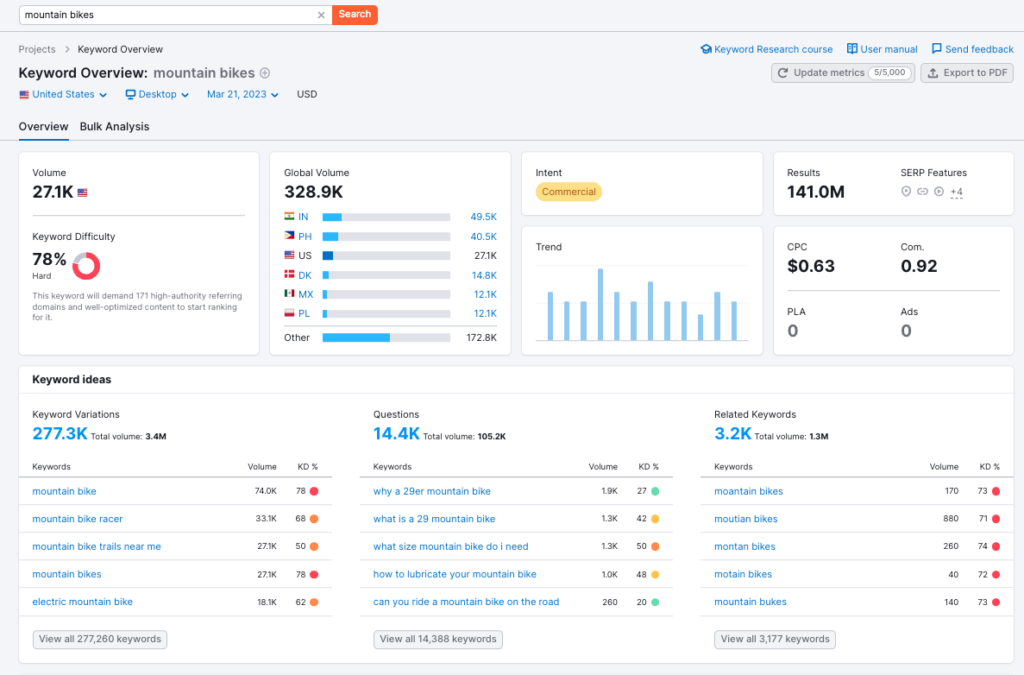
How do you prioritize keywords? Once you have a list of relevant queries, you’ll want to take note of the monthly search volume — how many searches are conducted for that term each month — in addition to the keyword difficulty provided by Semrush. The keyword difficulty score gives an estimate of how difficult it would be to rank well in organic search results for a particular keyword.
The sweet spot: keywords with decent monthly search volume that aren’t incredibly competitive. Of course, you want to make sure that the keywords you’re targeting are highly relevant to your business, too.
For even more strategic content planning, determine the search intent of your target keywords and develop your content accordingly.
2. Analyze the SERP
Once you have a list of priority keywords, you can start coming up with topics to tackle. Get some direction by returning to Google to analyze the SERP for each keyword, looking for the following:
- The type of content that ranks well — is it an FAQ page? A long-form blog?
- Your perception of the search intent for the term — are users searching for this term looking to learn about a topic, research their options, or are they ready to buy? Since over time, Google will rank web pages that answer the user’s search intent better, observe what well-ranking pages imply about the search intent.
- What headlines are working well — Are they formatted as questions or statements? Are there exact match keywords included in the metadata?
- What featured snippets (see screenshot below) are appearing? Are websites using structured data markup to achieve those results?
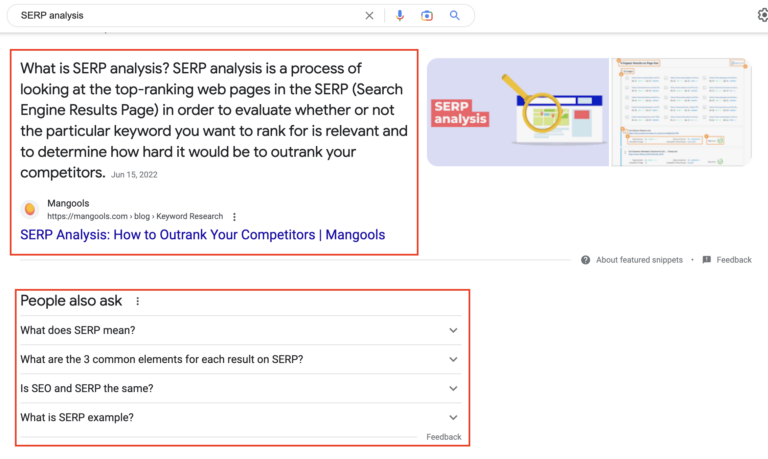
The biggest takeaway you’ll get from a SERP analysis is answering: “What are the top results not doing? How can we offer a unique angle, additional food for thought, and/or more robust information for users?” This thinking is how you can ensure your content is a value-add for your prospective customers.
3. Conduct a competitive content gap analysis
Similarly to a SERP analysis, a competitive gap analysis gathers data on how your competitors are ranking for your target keywords. It’s also a way to benchmark your own site’s organic performance.
At Two Octobers, we utilize tools like Semrush to identify search competitors, but it’s also possible to find them manually. If you’re a local business, conduct a Google search for your offerings from the location of your business. If you’re a national brand, make sure to use a location blocker so you can get the top results for the entire country.
From there, take note of who’s showing up on page one and in what position. This can be done at scale leveraging tools like SEMrush (and some spreadsheet skills).
Since our team is quite savvy in Sheets, that’s where we house our competitive analysis data. We also use Semrush to get more robust ranking data than manual searches can offer, exporting each domain’s ranking into a new sheet. Using VLOOKUP, we populate each competitor column with their respective ranking data.
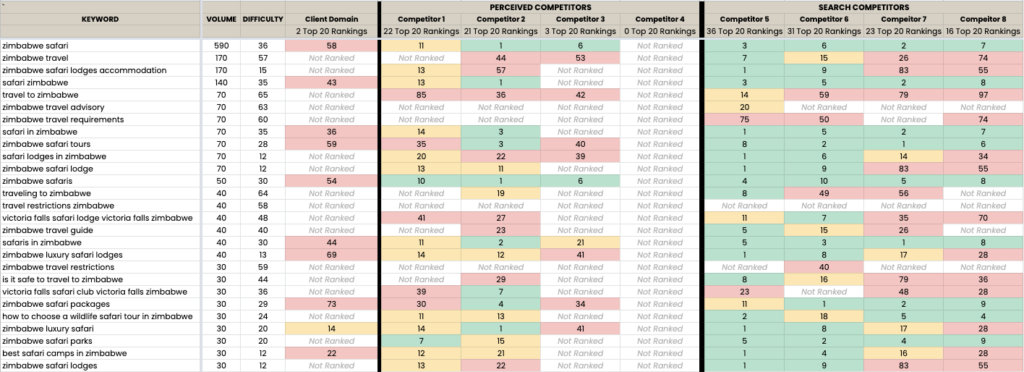
This is just one way — our way — to approach a competitive keyword gap analysis. With the data populated, we then identify short- and long-term opportunities based on how we’re ranking for our target keywords. Looking at the top-performing competitors, we can identify topics that we might be missing, in addition to content types and inclusions that are working well in search engines.
4. Look for low-hanging fruit to optimize or expand on
In the world of organic performance, low-hanging fruit is content that’s right on the cusp of page one, but needs a little boost.
Our competitive gap analysis process, as described above, identifies pages that are ranking on pages two and three of the SERP — there’s your low-hanging fruit!
For another way to go about finding low-hanging fruit, start with organic search query data found in Google Search Console (GSC) — or, for an even more robust look into your site data, use Branch Explorer, which displays millions of rows of Search Console data.
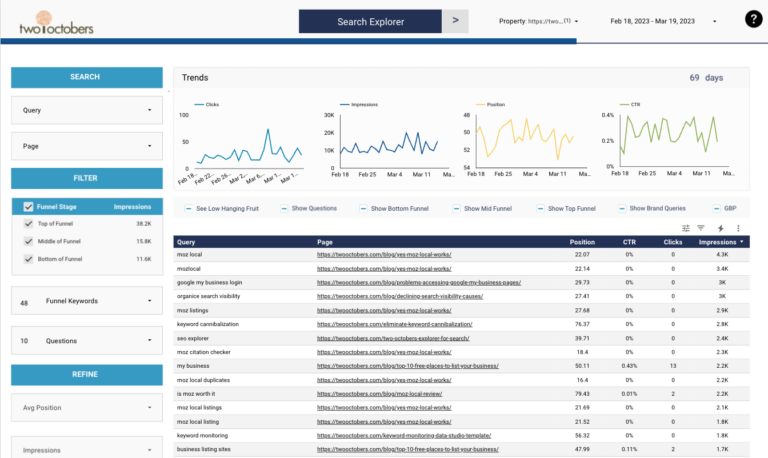
Once you’ve sought out pages to optimize, use our SEO cheat sheet to take the content to the next level.
Identifying low-hanging fruit pages can also inform your content development strategy — if your site is getting a lot of impressions for a certain keyword, are there additional keywords to target and/or topics to cover that relate? What queries are you getting impressions for that you’re not thoroughly addressing yet? As you parse through the data, the content ideas will start flowing.
5. Repurpose high-performing content
Similarly to identifying low-hanging fruit, find out which of your content is doing well — and run with it. Can you turn that listicle into an infographic? Can that video be transcribed for a blog? Repurposing what you already have is a time- and cost-efficient way to scale your content.
How you define “high-performing” depends on your unique business and website. If you get tens of thousands of visitors to your site monthly, your definition of high performance will be very different from a small business with only a few hundred web sessions each month.
In other words, you’ll need to benchmark your site’s performance in order to segment out content to keep as-is, optimize, repurpose, or get rid of.
There are a couple of different ways you could do this, the first being digging into your Analytics. In GA4, utilize the Pages and screens report to get a glimpse of your top pages based on traffic. For even more insight into user behavior, you can dig into engagement metrics in GA4.
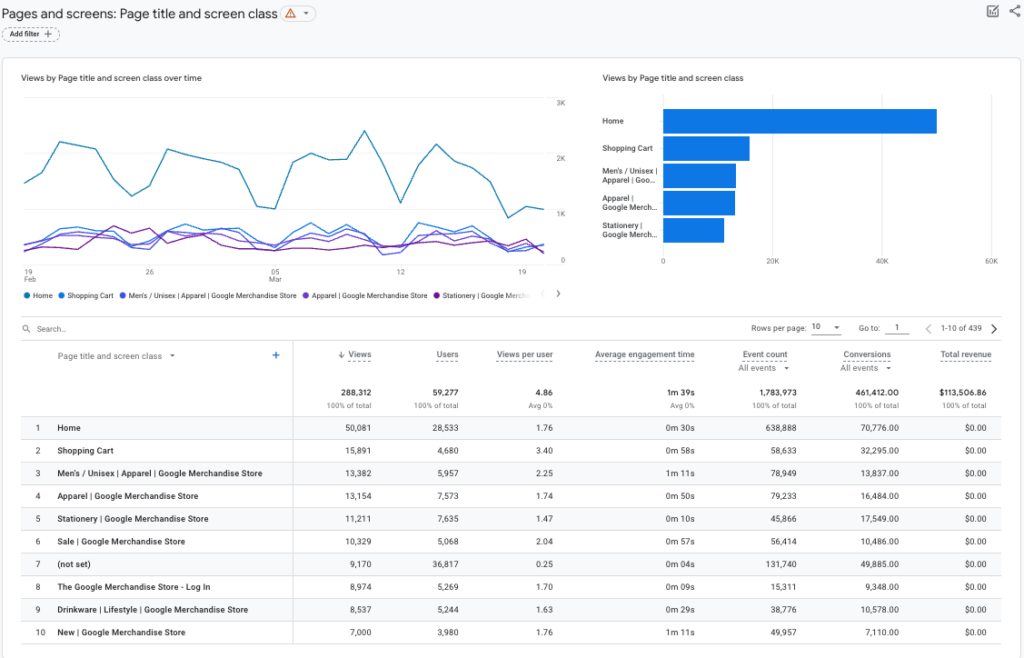
We recommend a comprehensive content audit at least once a year, but if you’re looking for quick wins through content repurposing, you can abbreviate the process and stick to identifying top performers.
6. Find content ideas on social media
If you know how to look, social media can provide a plentiful bounty of content ideas.
First, make sure you’re looking at data from social channels that your audience uses. Jumping on a TikTok trend, for example, won’t benefit your business if your target audience isn’t using it.
One of the best moves to make is to follow relevant thought leaders and influencers in your space. You know they have their finger on the pulse of the industry, so pay attention to what they’re posting about.
You should also check out trending hashtags (on platforms that use them, like Instagram and Twitter) and topics based on posts and searches.

Pinterest even has a designated Trends dashboard that can be filtered by keyword, interests, demographics, and more.
Don’t sleep on forums, either — Reddit and Quora are fantastic platforms to keep your ear to the ground and find out what people are asking and discussing.
Related: Learn more about how social media and SEO work together.
7. Use trending topics tools
There are several free or freemium tools that provide a ton of search data that makes content ideation a breeze.
Google Trends is free to use and serves up real-time search data. You can look at overall trends or plug in your specific keywords to see the interest over time — daily, monthly, annually, etc.

BuzzSumo offers a 30-day free trial and features content discovery by platform, content type, time period, and more.
Semrush includes a Topic Research tool that provides search data on related topics to your chosen keyword. They also offer a free trial.
Need help with data analysis and content ideation?
With all of these paths to content ideation, it can be difficult to prioritize and plan. Here at Two Octobers, we use data to guide every decision we make. Our teams of analytics and content experts work together to develop comprehensive content strategies that drive results. Want to work with us? We’d love to hear from you!




